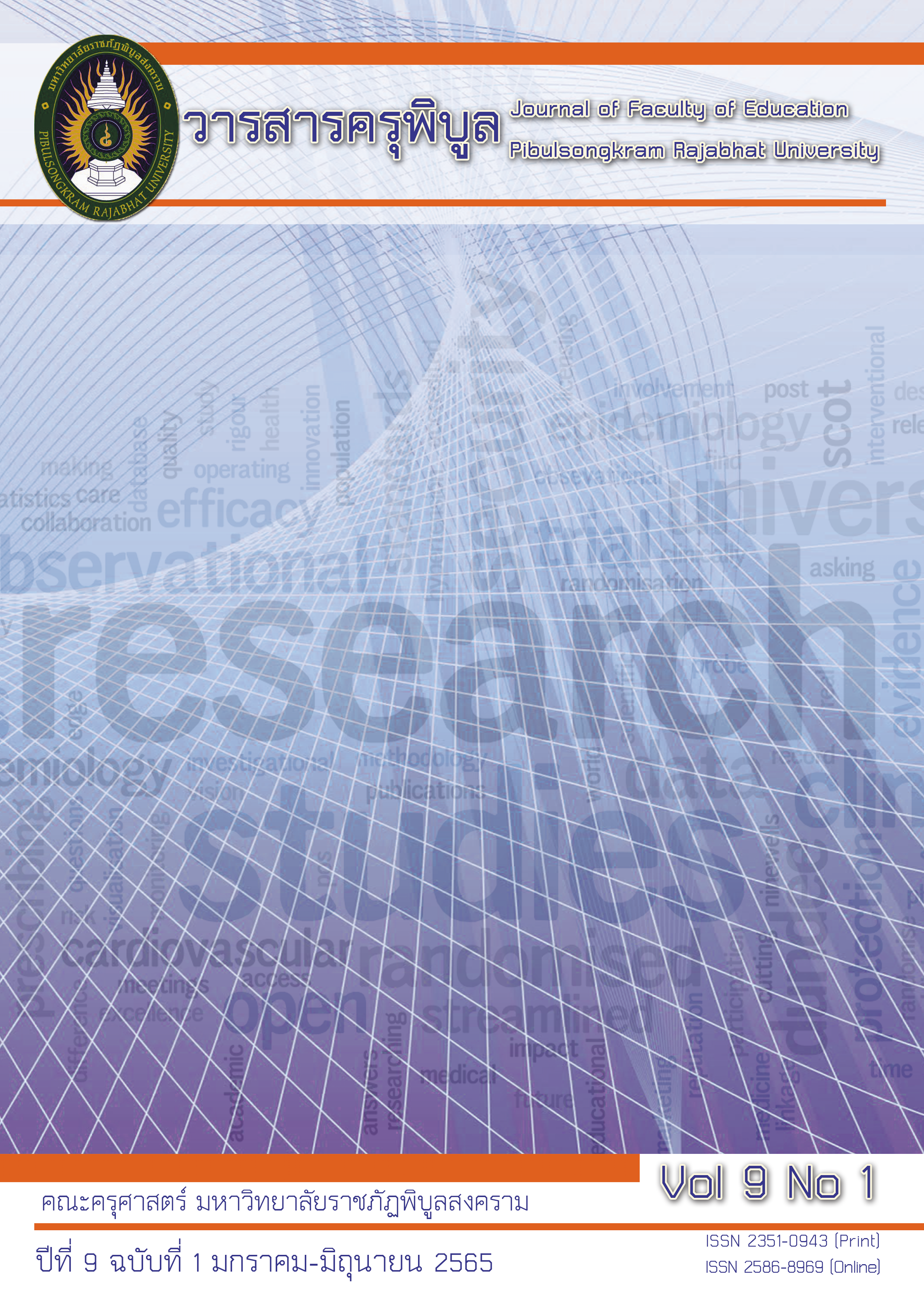The Development of Collaboration Skill Indicators of Undergraduate Students
Keywords:
ตัวชี้วัด ทักษะการทำงานร่วมกับผู้อื่น นิสิตระดับปริญญาตรีAbstract
This research aims to 1) develop the factors and indicators of the collaboration skills of undergraduate students 2) to check construct validity of factors and Collaboration Skill Indicators of Undergraduate Students. The samples are 400 first to fourth year undergraduate students, of academic year 2020. They were selected by using Multistage-stage Random Sampling. The research tool is questionnaire, based on Likert’s Fiver-Rating Scale, focusing on Collaboration Skill Indicators of Undergraduate Students. The Data were analyzed by using frequency distributions, median, interquartile range, percentage, mean, standard deviation and coefficient correlation by statistical package and second order confirmatory factor analysis by LISREL program in order to check the construct validity and the indicator validity of Collaboration Skill Indicators of Undergraduate Students.
It was found that the factors and indicators of the collaboration skills of undergraduate students can be divided into 5 factors and 17 indicators. The first factor is Performance Skills, consisting of 4 indicators. The second factor is Interaction Skills, consisting of 4 indicators. The third factor is Communication Skills, consisting of 3 indicators. The fourth factor is Listening and Summing-Up Skills, consisting of 3 indicators. And the fifth factor is Systematic Thinking Skills, consisting of 3 indicators. The results also shown that the developed model of the factors Collaboration Skill Indicators of Undergraduate Students is harmonious with the empirical data. The chi square is 398.378 (P=0.000 ), P at Degree of Freedom is equal to 94, The Comparative Fit Index is 0.952, The Tucker-Lewis Index is 0.931, The Standard Root Mean Square Residual is 0.041 and the Root Mean Square Error of Approximation is 0.009 . This means the model of the factors and Collaboration Skill Indicators of Undergraduate Students has statistical significant for the factors and indicators weight at .01 and it shows that the model of the factors and Collaboration Skill Indicators of Undergraduate Students has the construct validity.
References
จริยา บุพพารัมณีย์. (2552). ทักษะส่วนบุคคลที่ใช้ในการทำงานร่วมกับผู้อื่นของผู้สอบบัญชี: มุมมองของผู้ทำบัญชีและผู้สอบบัญชี. วิทยานิพนธ์บริหารธุรกิจมหาบัณฑิต, มหาวิทยาลัยสงขลานครินทร์.
ญาณี วัฒนากร. (2558). การพัฒนาลักษณะเฉพาะของแบบวัดทักษะการทำงานร่วมกับผู้อื่นแห่งศตวรรษที่ 21 ของนิสิตนักศึกษาปริญญาตรี. วิทยานิพนธ์ครุศาสตรมหาบัณฑิต, จุฬาลงกรณ์มหาวิทยาลัย.
ณัฏฐพันธ์ เขจรนันทน์และคณะ. (2546). กลยุทธ์การสร้างองค์การคุณภาพ. กรุงเทพฯ: ธรรมกมลการพิมพ์.
นงลักษณ์ ใจฉลาด. (2563). องค์ประกอบและกิจกรรมตัวบ่งชี้พัฒนาคุณลักษณะที่พึงประสงค์ของนักศึกษา มหาวิทยาลัยราชภัฎพิบูลสงคราม. Journal of Faculty of Education Pibulsongkram Rajabhat University, 7(1), 132-144.
ทิศนา แขมมณี (2545). ศาสตร์การสอน. กรุงเทพฯ: สำนักพิมพ์แห่งจุฬาลงกรณ์มหาวิทยาลัย.
พงษ์กรณ์ วีรพิพรรธน์. (2554). ผลการใช้รูปแบบจิ๊กซอว์ที่มีต่อผลสัมฤทธิ์ทางการเรียนภาษาไทยและทักษะการทำงานร่วมกับผู้อื่นของนักเรียนมัธยมศึกษาปีที่ 3. วิทยานิพนธ์ครุศาสตร มหาบัณฑิต, จุฬาลงกรณ์มหาวิทยาลัย.
มัลลิกา ต้นสอน. (2544). พฤติกรรมองค์การ. กรุงเทพฯ : เอ็กซเปอร์เน็ท.
สมคิด บุญเรือง. (2546). ผลการใช้โปรแกรมความฉลาดทางอารมณ์เพื่อพัฒนาทักษะการทำงานร่วมกับผู้อื่นของพนักงาน บริษัท อะโรเมติกส์ (ประเทศไทย) จำกัด (มหาชน). วิทยานิพนธ์: วิทยาศาสตรมหาบัณฑิต, มหาวิทยาลัยบูรพา.
สุนันทา เลาหนันทน์ (2549). เอกสารการสอนการทำงานเป็นทีม. (พิมพ์ครั้งที่ 3). กรุงเทพฯ: แฮนด์เมคสติกเกอร์แอนดีดีไซน์.
อารี เพชรผุด. (2521). มนุษยสัมพันธ์ในการทำงาน. กรุงเทพฯ: เนติกุลการพิมพ์.
อนุ เจริญวงศ์ระยับ. (2549) การแสดงหลักฐานความเที่ยงตรงเชิงโครงสร้างของแบบประเมินการสอนโดยผู้เรียนของมาร์ชด้วยการประยุกต์วิธีการวิเคราะห์กลุ่มพหุ. วิทยานิพนธ์การศึกษามหาบัณฑิต บัณฑิตวิทยาลัย มหาวิทยาลัยศรีนครินทรวิโรฒ
Johnson, D. W. ; Johnson, R.T. and Smith, K. A. (1991). Cooperative Learning Increasing College Faculty Instructional Productivity. Higher Education Report No. 4. Washington D.C. : The George Washington University.
Hu, L., & Bentler, P. M. (1999). Cutoff criteria for fit indexes in covariance
structure analysis: Conventional criteria versus new alternatives.
Structural Equation Modeling, 6, 1-55.
Schumacker, R. E., & Lomax, R. G. (2010). A beginner’s guide to structural
equation modeling (3rd ed.). New York, NY: Routledge Academic.
Downloads
Published
Issue
Section
License
Copyright (c) 2022 คณะครุศาสตร์ มหาวิทยาลัยราชภัฏพิบูลสงคราม

This work is licensed under a Creative Commons Attribution-NonCommercial-NoDerivatives 4.0 International License.
ลิขสิทธิ์เป็นของคณะครุศาสตร์ มหาวิทยาลัยราชภัฏพิบูลสงคราม


